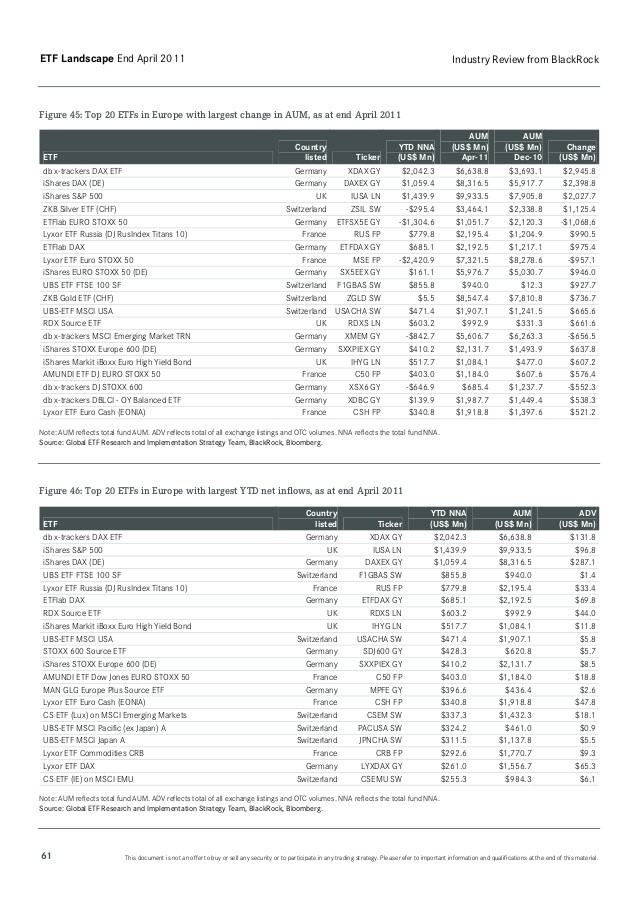BlackRock takes ETF lead back from Vanguard in Q2
Post on: 8 Май, 2015 No Comment

BlackRock Inc. the world’s biggest money manager, attracted more cash to its U.S. exchange-traded funds than any competitor in the second quarter as it benefited from resurgent emerging markets.
BlackRock’s iShares lineup took in an estimated $18.1 billion in net deposits in the quarter through June 30, just ahead of first-quarter leader Vanguard Group Inc. also at $18.1 billion, according to data compiled by Bloomberg. IShares funds focusing on emerging markets captured $8 billion, including $6 billion for top seller iShares MSCI Emerging Markets ETF .
“A lot of that is clearly institutional money as the Fed’s forward guidance has made those investors much more comfortable dipping their toes into emerging markets,” Dave Nadig, chief investment officer at San Francisco–based research firm ETF.com, said in a telephone interview.
Emerging-market equities rallied as investors grew more confident the U.S. Federal Reserve will keep interest rates near zero into next year and as the political crisis involving Russia and Ukraine calmed. The iShares fund returned 6.2 percent since the end of March after falling 2 percent in the previous 12 months and 11 percent over three years.
The same factors bolstered debt in developing markets. The iShares J.P. Morgan USD Emerging Markets Bond ETF returned 4.6 percent last quarter and attracted $1.3 billion in deposits.
BlackRock, the New York-based company whose $717 billion in U.S. ETFs make it the industry’s largest provider, had seen Vanguard close ground in four of the previous five quarters through its appeal to individual investors.
Vanguard, which is based in Valley Forge, Pennsylvania, and began offering ETFs in 2001, oversees $384 billion in U.S. ETFs, ranking third in the segment.
State Street Corp. whose $404 billion in U.S. ETFs make it the second-biggest competitor, bounced back from first-quarter redemptions to gather $8.9 billion in the latest three months.
The firm’s ETF assets are especially sensitive to institutional investor shifts into and out of big U.S. stocks. The $168 billion SPDR S&P 500 ETF Trust, the world’s largest exchange-traded fund, accounts for more than 40 percent of State Street’s U.S. ETF assets.
The fund had $4.2 billion in deposits, second-most in the quarter, after losing $19 billion in the year’s first three months. It gained 5.2 percent as the U.S. benchmark rallied.
Invesco Ltd.’s PowerShares QQQ Trust had the quarter’s heaviest redemptions. The fund, known as QQQ for its ticker symbol, lost $3 billion to withdrawals even as it returned 7.4 percent. The Nasdaq-100 Total Return Index tracked by the fund trades at about 23 times reported earnings, compared with a multiple of 18 for the broader S&P 500.
Fidelity Investments, the second-biggest mutual fund company, had the fastest growth rate among all U.S. ETF providers less than a year after making its first concerted push into the market.
The Boston-based company’s 11 ETFs, including 10 single- industry funds opened in October, gathered $545 million in the quarter, helping to boost its assets in the product by 63 percent to $1.5 billion, according to data compiled by Bloomberg.
“Sector ETF investing continues to grow in popularity and Fidelity has the cheapest sector ETFs around,” Todd Rosenbluth, director of mutual fund and ETF research for S&P Capital IQ in New York, said in a telephone interview.
In dollar terms, Fidelity ranked ninth in deposits for the quarter. The firm is 27th in market share.
U.S. ETFs took in a collective $53.7 billion in the quarter as assets climbed to $1.86 trillion. ETFs are bundles of securities that trade like stocks on an exchange and typically track an equity, bond, commodity or currency index.














